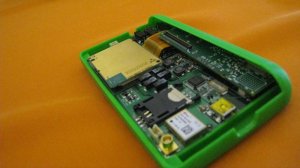What is in a cell phone?

On a "complexity per cubic inch" scale, cell phones are some of the most intricate devices people use on a daily basis. Modern cell phones can process millions of calculations per second in order to compress and decompress the voice stream. If you have read How Cell Phones Work, you know that they can transmit and receive on hundreds of FM channels, switching channels in sync with base stations as the phone moves between cells.
If you ever take a cell phone apart you will find that it contains just a few individual parts:
- A microscopic microphone
- An antenna
- An amazing circuit board containing the guts of the phone
In this picture several of the components are identified. Starting from the left you the see the Analog-to-Digital and Digital-to-Analog conversion chips. You can learn more about A-to-D and D-to-A conversion and its importance to digital audio in How CDs Work. The DSP is a "Digital Signal Processor" - a highly customized processor designed to perform signal manipulation calculations at high speed. This DSP is rated at about 40 MIPS (Millions of Instructions per Second) and handles all the signal compression and decompression. The microprocessor (Ericsson phones use an ASIC version of the Z-80) and memory handle all of the housekeeping chores for the keyboard and display, deal with command and control signaling with the base station and also coordinate the rest of the functions on the board. The RF and power section handles power management and recharging and also deals with the hundreds of FM channels. Finally the RF (Radio Frequency) amplifiers handle signals in and out of the antenna.
What is amazing is that all of that functionality - which only 30 years ago would have filled the entire floor of an office building - now fits into a package that sits comfortably in the palm of your hand.
Source: electronics.howstuffworks.com

|
SanDisk Ultra 64GB microSDXC UHS-I Card with Adapter, Grey/Red, Standard Packaging (SDSQUNC-064G-GN6MA) Personal Computer (Sandisk)
|






